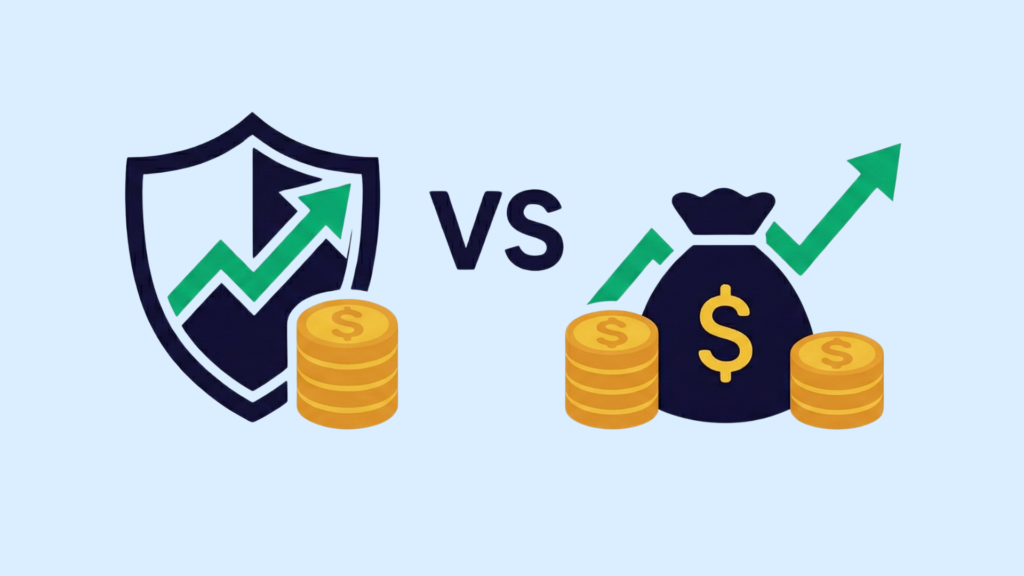When choosing between mutual funds and PPF, there’s no one-size-fits-all answer — each serves a different purpose. While PPF (Public Provident Fund) offers safety and tax-free fixed returns, mutual fund investment provides market-linked growth and flexibility.
The better option is dependent on your financial goals, risk appetite, and investment horizon. In this article, we’ll discuss more about how mutual funds and PPFs work and how they differ from each other. Read along!
What are Mutual Funds?
A mutual fund is an investment instrument that takes money from multiple investors to invest in a portfolio of diverse assets that includes stocks, bonds, or both. These funds are managed by professional/experienced fund managers.
Here’s how mutual fund investment works:
- You invest in units of a mutual fund scheme.
- The fund manager allocates this clubbed money in different securities based on the fund’s objective.
Types of mutual funds include:
- Equity funds: Invest mainly in stocks and offer higher return potential with higher risk.
- Debt funds: Invest in debt instruments—bonds and fixed-income instruments— and has lower risk and stable returns,
- Hybrid funds: Combines both equity and debt for balanced risk and return.
In terms of taxation, gains are taxed upon redemption. For Equity Mutual Funds (including ELSS), gains on units held for less than one year are Short-Term Capital Gains (STCG), taxed at 15%. Gains on units held for more than a year are Long-Term Capital Gains (LTCG), taxed at 10% on gains exceeding ₹1 lakh per year. For Debt Mutual Funds, as per rules effective from April 1, 2023, all gains, regardless of the holding period, are considered short-term and are taxed at your income tax slab rate.
In short, what is a mutual fund investment? It’s a market-linked and professionally managed option that offers diversification, growth potential and easy access to your money.
What Is Public Provident Fund (PPF)?
Public Provident Fund (PPF) is a long-term, government-backed savings scheme designed to encourage disciplined investing with tax benefits. It is very popular among conservative investors because of its predictable returns.
Here’s how PPF investment works:
- You can open a PPF account via a bank or post office.
- The minimum investment is usually ₹500 per year and the maximum is ₹1.5 lakh.
- The government sets the fixed interest rate which is revised quarterly.
The lock-in period is 15 years. Partial withdrawals, however, are allowed from the seventh year, and loans can be taken against the balance from the 3rd year.
Tax benefits under Section 80C make it even more attractive:
- Contributions are tax-deductible up to ₹1.5 lakh.
- The interest that you earn and maturity proceeds are completely tax-free (EEE status).
In summary, what is public provident fund? It’s a secure and long-term investment tool that gives you guaranteed returns and tax benefits.
PPF Vs Mutual Funds – Key Differences
Both PPF and mutual funds are popular investment options in India, but they serve different purposes. While PPF investment target safety and long-term stability, mutual fund investment shift their focus towards higher returns via market participation.
Here’s a quick comparison to help you choose based on your financial goals.
| Feature | PPF (Public Provident Fund) | Mutual Funds |
| Nature of Investment | Government-backed fixed income | Market-linked (equity, debt, or hybrid) |
| Returns | Fixed and declared quarterly (currently ~7% p.a.) | Varies based on fund type and market performance |
| Risk Level | Very low | Moderate to high (depending on fund category) |
| Lock-in Period | 15 years | No lock-in (except ELSS – 3 years) |
| Liquidity | Limited withdrawals are allowed from year 7 | High liquidity (can be redeemed anytime, subject to exit load) |
| Tax Benefits (Sec 80C) | Yes – up to ₹1.5 lakh; EEE (exempt on maturity) | Yes – only for ELSS funds; other funds may attract tax |
| Best For | Long-term, low-risk saving and retirement planning | Wealth creation, short- and long-term financial goals |
Mutual Funds Vs PPF: Which Is Better for You?
When you select the right mutual funds or PPF you need to take into account your financial goals, risk tolerance, and time horizon. Both have distinct advantages, but they serve different purposes in a portfolio.
- Goal-based suitability (short vs long-term):
- Mutual fund investments are best if you’re looking for short- to medium-term (3–7 years) and long-term investments like wealth creation, a child’s education, or retirement.
- PPF investment is strictly long-term (15 years lock-in), making it suitable for stable goals like retirement or building a safety net.
- Risk appetite consideration:
- Mutual funds come with market-linked returns, so they are best for investors with moderate to high risk tolerance.
- PPF is best for conservative investors who prefer capital safety and predictable returns, regardless of market conditions.
- Return expectations:
- Mutual funds offer potentially higher returns (especially equity funds), but with fluctuations.
- PPF provides fixed and tax-free returns, but they’re generally lower and may not always beat inflation.
- Tax planning needs:
- Both qualify for Section 80C tax benefits up to ₹1.5 lakh per year.
- PPF offers EEE status — tax-free at all stages.
- Mutual funds (ELSS specifically) offer tax savings, but other mutual funds may attract capital gains tax on redemption.
Can You Invest in Both Mutual Funds and PPF?
Yes, you can and in many cases, you should. Investing in both mutual funds and PPF allows you to build a well-balanced portfolio that meets different financial needs across time horizons.
Benefits of Diversification
By investing in both options, you reduce your dependency on a single asset class. PPF offers capital protection and stable, tax-free returns but mutual funds investment gives you access to market-linked growth. This mix helps you manage risk while still targeting higher returns.
Balancing Risk and Returns
The PPF investment acts as the low-risk, stable component of your portfolio, suitable for long-term goals like retirement. Meanwhile, mutual funds, especially equity funds, can grow your wealth faster over time, but with higher risk. Combining both helps absorb market volatility while keeping your overall returns competitive.
Suggested Asset Allocation Strategy
A simple rule to follow is the “100 minus age” strategy for equity exposure:
- In your 20s and 30s: Allocate 70–80% to mutual funds, 20–30% to PPF.
- In your 40s: 60% mutual funds, 40% PPF.
- In your 50s and beyond: Shift gradually to 40% mutual funds, 60% PPF.
However, make sure to adjust the mix based on your income, financial objectives, and risk appetite.
Pros and Cons of Mutual Funds and PPF
While mutual funds focus on growth through market participation, PPF prioritises safety and tax-free returns. Here’s a quick look at the pros and cons of each to help you decide what fits your financial strategy:
Mutual Funds
- Pros:
- High return potential: Especially with equity mutual funds over the long term.
- Flexibility: You can invest or withdraw at your convenience (except for ELSS), though exit loads may apply to early withdrawals.
- Wide choice: Various types — equity, debt, hybrid — to match different goals and risk profiles.
- Cons:
- Market risk: Returns are dependent on market performance and are not fixed.
- No guaranteed returns: Profits can fluctuate, and losses are possible.
PPF
- Pros:
- Safe investment: Backed by the government with no market risk.
- Tax-free returns: Interest and maturity amounts are fully exempt under EEE status.
- Long-term focus: Encourages disciplined savings for future needs like retirement.
- Cons:
- 15-year lock-in: Limited access to funds during the tenure.
- Low liquidity: Partial withdrawals are restricted and allowed only under specific conditions.
- Interest rate changes: Returns are revised quarterly and may not always keep up with inflation.
Conclusion
Mutual funds are better for investors seeking growth and flexibility, offering the potential for higher returns through market-linked investments. They work well for medium to long-term goals and allow easy access to your money when needed.
On the other hand, PPF is ideal for those who prioritise capital protection and a tax-free corpus, especially for long-term savings like retirement. It offers stability, government backing, and guaranteed returns.
Ultimately, your choice between mutual funds and PPF should be aligned with your investment goals, tolerance for risk, and investment timeline. In many cases, a combination of both can provide a balanced approach to building wealth.
FAQs
What are the tax benefits of PPF and mutual funds?
Under Section 80C, both PPF and ELSS mutual funds offer tax deductions up to ₹1.5 lakh annually. However, their overall tax treatment differs. PPF enjoys EEE (Exempt-Exempt-Exempt) status, meaning the contribution, interest, and maturity amount are all tax-free. For mutual funds, only ELSS offers the initial deduction. All other mutual fund gains are taxable upon redemption as per capital gains tax rules.
Can I invest in both mutual funds and PPF simultaneously?
Yes, you can invest in both at the same time. Combining PPF and mutual funds allows you to balance safety with growth. PPF investment offers fixed returns and tax-free interest, while mutual fund investments give you market-linked returns and flexibility.
Which gives better returns: PPF or mutual funds?
In the long run, mutual funds (especially equity mutual funds) have the potential to deliver higher returns than PPF. However, they carry market risk. PPF returns are fixed and safer but generally lower. So, when comparing mutual funds vs PPF, the choice is dependent on your risk appetite and investment goals.
Is PPF a better option for retirement than mutual funds?
PPF can be a good retirement tool due to its safety, long lock-in, and tax-free returns. However, relying only on PPF investment may not be enough to beat inflation. A mix of PPF and mutual funds offers both stability and growth, making it more suitable for long-term retirement planning.
What are the risks involved in mutual fund investments?
The main risks in mutual fund investments are market volatility, interest rate fluctuations (for debt funds), and fund manager performance. Unlike PPF, mutual funds are not guaranteed and can result in losses. But with proper selection and a long-term view, risks can be managed and returns can outperform fixed-income options.
Disclaimer
The information provided in this article is for educational and informational purposes only. It should not be considered as financial or investment advice. Investing in stocks involves risk, and it is important to conduct your research and consult with a qualified financial advisor before making any investment decisions. The author and publisher are not responsible for any financial losses or gains that may result from the use of this information.























